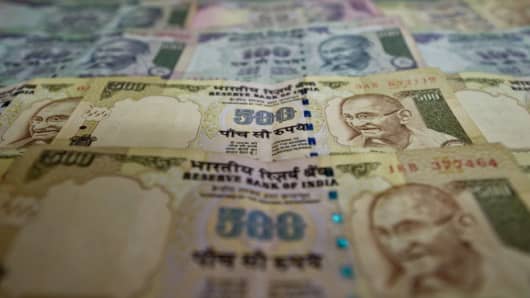While the rapid depreciation in the Indian rupee and a negative external environment prompted the country's central bank to hold fire at its latest policy meeting on Monday, economists are still betting on multiple rate cuts before year-end.
The Reserve Bank of India kept interest rates steady at 7.25 percent, citing risks of inflation as a result of the weakening rupee - which has declined 7.4 percent against the dollar since the start of May.
So far this year, the RBI has lowered rates by 75 basis points in order to boost flagging growth, but India watchers see an additional 50-75 basis points in cuts during the second half.
(Read More: India Leaves Rates Unchanged)
"A further weakness in growth, further deceleration in inflation and an improvement in the current account are the three conditions for further easing. And we believe all three of those developments will continue to take hold," said Taimur Baig, chief economist for India at Deutsche Bank told CNBC-TV 18, referring to the central bank's policy statement.
Baig said he is not worried about inflationary pressures stemming from a weaker currency, noting that there are "massive disinflationary forces in the pipeline" stemming from lower global commodity prices. In addition, with a positive start to the monsoon season, he noted that food prices are likely to remain stable.
"Inflation is falling like a rock and it will keep falling and perhaps even go to low 4 percent by August or September if the monsoon turns out to be a good one," he said.
India's Wholesale price index (WPI), the main gauge of inflation, slowed for a fourth straight month in May to 4.7 percent from a year earlier, staying within the central bank's comfort zone of around 5 percent.
"I'm comfortable calling for additional rate cuts regardless of what happens with the rupee," he said.
(Read More: Why Emerging Markets Are Still on Shaky Ground)
Sonal Varma, chief India economist at Nomura, agreed that the current growth-inflation dynamic calls for further monetary easing, forecasting 50 basis points in rate cuts this year.
"The forward guidance suggests that the RBI's policy stance is still biased towards cutting rates. (But) CPI inflation and the rupee likely to determine the timing of the moves," Varma said.
Asia's third largest economy has been disappointing over the past year, with growth remaining sluggish in the January to March period at 4.8 percent from 4.7 percent in the previous quarter.
(Read More: Why Market Watchers Aren't Giving Up on India)





